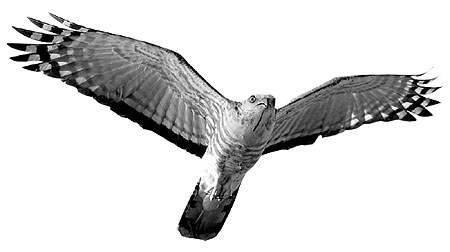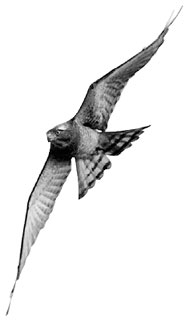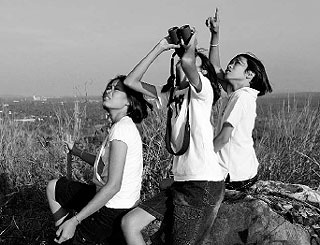
|
||||||||||
|
||||||||||
| Favorite Tweets by @thaibirding | ||||||||||
|
||||||||||
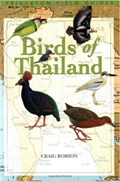 Buy Birds of Thailand on Amazon.co.uk |
||||||||||
| Site Map ; Contributors |
Raptor
Migration in By Deborah Allen and Robert DeCandido, PhD |
||||
| Note: This article was originally published in Hawk Mountain News, Autumn 2007 and was kindly submitted by Robert DeCandido. | ||||
It was autumn 2002 when a post on the Asian Raptor Research and Conservation Network website made me do a double-take. A young Thai government officer named Chukiat Nualsri had observed and was now counting birds of prey in Thailand. What Chukiat didn’t realize, and what I instantly suspected, was that he may have uncovered a migration flyway of global significance. Having studied raptor migration in Asia, I knew I could help, and tapped out an immediate email. And so began an Asian raptor watch site, and long-distance friendship, on the other side of the globe. I first learned through our email correspondence that Chukiat had noticed the birds on a September morning in 1997, at first just a few, and then, a monsoon of large birds passing his house. Later that same afternoon, he noticed the birds still moving south overhead. Throughout the autumn he observed the birds only in the morning and late afternoon, and always headed in the same direction. A year passed, and in 1998, the birds reappeared over Chukiat’s home on the east coast of Thailand. Despite his best efforts, he could not determine their identity. Friends knew little about wild birds, and there were no field guides in Thai. Getting a close look was nearly impossible, as binoculars were too expensive. Answers to simple questions remained a mystery. Where did the birds go? Where did they come from? Why did they travel in groups? How many passed? Why did he only see them in autumn? Where did the birds disappear to each afternoon? |
||||
|
||||
In order to maximize educational outreach, Chukiat convinced his colleagues in the regional government to sponsor an autumn raptor watch. At first, a small amount of funding was budgeted to print posters, flyers and even highway signs that emphasized the importance of Thailand and its people for birds of prey. Articles about the migration began to appear in newspapers throughout the country. Birders and non-birders, curious to know more about the big birds passing through Thailand, began to visit. The regional government realized the eco-tourism potential, and increase funds to purchase binoculars and spotting scopes. This year, more than $5,000 was pledged annually for the migration count at Chumphon, and the watchsite attracted corporate sponsors. Like other migration watch-sites around the world, this count remains a success because of Chukiat and his cadre of volunteers, who view the migration as a gift from Buddha to all Thai people to enjoy, study and protect. |
||||
|
||||
|
||||
The realization that some Asian birds of prey crossed water and migrated at night caused me to re-examine my own beliefs about raptor migration. In North America, most biologists are taught that migrating birds of prey only travel by day, and rarely if ever, cross large water bodies. In eastern Asia, night flight and water crossings are fairly common as birds travel from the mainland to outlying islands in Indonesia. |
||||
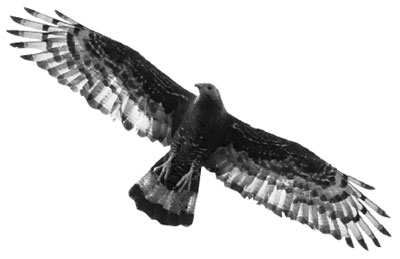 The Oriental Honey-buzzard sometimes migrates at night. (Photo - Deborah Allen & Robert DeCandido, PhD) |
||||
Along with Chukiat, I was curious to learn why the raptor flight seemed to disappear from noon until 3 pm. We solved this puzzle by watching raptors closely as they rose higher and higher in thermals during the middle of the day. In the tropics thermals are so strong, raptors often went out of sight, and it was not unusual to see flocks of Chinese Sparrowhawks disappear into the clouds. By flying so high, these raptors are able to migrate above rainstorms. We also learned why Chukiat only saw raptors passing over his home near the coast in autumn but not spring: From August through mid-November, raptors presumably drift toward the coast with the prevailing northwest wind. In spring, the prevailing wind is from the east, so the migrants drift several miles inland with these onshore winds. Together with Chukiat and his network of volunteers, we are working to solve other mysteries of raptor migration, and this is just the beginning of a successful international conservation effort. Experience has taught us that raptors are ambassadors of the environment. Both in Thailand and at Hawk Mountain, people will stop to gaze skyward when flocks of raptors pass overhead. Our mission is to channel this fascination into a long-term commitment to protect raptors, and to conserve the environment for all. |
||||
|
||||
| About
the authors Authors Robert DeCandido and Deborah Allen have conducted raptor migration research in Asia from Israel and Turkey east to Nepal and south to Malaysia since 1998. At home in New York City, they are studying urban nesting kestrels in Gotham. |
||||
| About the Adverts |
||||
| Related
Pages: |
||||

A Guide to Birdwatching in Thailand. Copyright © 2004-2017 thaibirding.com. All rights reserved.
